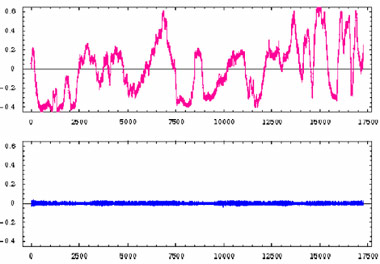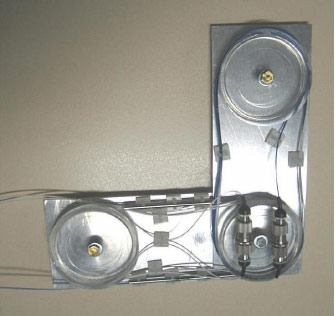Optical Fiber Interferometer Detects Dynamical 3-Space Turbulence
Interferometers have traditionally been used to try and determine our motion with respect to space. They were massive instruments that weighed tons and required serious work to construct and months to perform the measurements. Now Prof. Reginald Cahill, an Australian scientist at Flinders University in Adelaide, has brought fiber optics to the field of interferometry and has, with a relatively simple set-up, detected not only variations of the earth's speed with regard to the background of space, but also gravitational waves, a kind of 'turbulence' in space.
The instrument made by Cahill's group of physicists is extremely small and light, in sharp contrast with its historical predecessors. It can be constructed for just over 1100 dollars - Cahill's paper provides a parts list - and what's better yet, the instrument can be modified to make three-dimensional measurements by adding another 'arm' at right angles to its current configuration.
"By having three mutually orthogonal optical-fiber interferometers it is possible to deduce the vectorial direction of v(r; t), and so determine, in particular, if the pulses have any particular direction, and so a particular source. The simplicity of this device means that an international network of detectors may be easily set up, primarily to test for correlations in the waveforms."

The detector has an extremely high signal-to-noise ratio as shown in the above plots, where the detector mode (red plot) shows definite variations, while the neutral mode (blue) only shows instrument noise.
It seems that this neat new piece of instrumentation will not only allow research into gravity but may also help resolve the centenary controversy over the existence of an aether, or rather some properties of space that provide a reference frame for physical phenomena. Einstein's relativity that does not allow for such a preferential reference frame may be up for revision.
- - -
Cahill's paper Optical-Fiber GravitationalWave Detector: Dynamical 3-Space has been accepted for publication in Progress in Physics and will appear in the October 2007 issue.
From the introduction:
Preliminary results from an optical-fiber gravitational wave interferometric detector are reported. The detector is very small, cheap and simple to build and operate, and is shown in Fig. 1.

It is assembled from readily available opto-electronic components, and is suitable for amateur and physics undergraduate laboratories. A parts list is given. The detector can operate in two modes: one in which only instrumental noise is detected, and the 2nd in which the gravitational waves are detected as well. Comparison shows that the instrument has a high S/N ratio. The frequency spectrum of the gravitational waves shows a pink noise spectrum, from essentially 0 to 0.1 Hz. The interferometer is 2nd order in v=c and is analogous to a Michelson interferometer. Michelson interferometers in vacuum mode cannot detect the lightspeed anisotropy e ect or the gravitational waves manifesting as light-speed anisotropy fluctuations. The design and operation as well as preliminary data analysis are reported here so that duplicate detectors may be constructed to study correlations over various distances. The source of the gravitational waves is unknown, but a 3D multi-interferometer detector will soon be able to detect directional characteristics of the waves.
To read the whole paper:
Optical-Fiber GravitationalWave Detector: Dynamical 3-Space Turbulence Detected
- - -
A more recent paper by Reg Cahill regarding earth flyby anomalies observed in satellites:
Resolving Spacecraft Earth-Flyby Anomalies with Measured Light Speed Anisotropy (PDF)
Doppler shift observations of spacecraft, such as Galileo, NEAR, Cassini, Rosetta and MESSENGER in earth flybys, have all revealed unexplained speed 'anomalies' - that the doppler shift determined speeds are inconsistent with expected speeds. Here it is shown that these speed anomalies are not real and are actually the result of using an incorrect relationship between the observed doppler shift and the speed of the spacecraft - a relationship based on the assumption that the speed of light is isotropic in all frames, viz invariant. Taking account of the repeatedly measured light speed anisotropy the anomalies are resolved ab initio. The Pioneer 10/11 anomalies are discussed, but not resolved. The spacecraft observations demonstrate again that the speed of light is not invariant, and is isotropic only with respect to a dynamical 3-space. The existing doppler shift data also offers a resource to characterise a new form of gravitational waves, the dynamical 3-space turbulence, that has also been detected by other techniques.
See also related:
Process Physics Finds Absolute Motion In 3-Space
Process Physics at Flinders University School of Chemistry, Physics and Earth Sciences





Eric Krieg comments (by email):
I think it is most likely that these process physics people are deluded. But in the event they have proven the mainstream wrong, I would love to see their work validated and awarded with a nobel prize.
My reply:
We might have to wait for a while for the validation - those things take time.
Meanwhile, let's give them some space.
And Eric comments again:
I would validate it by seeing if multiple instruments get clearly different readings as the earth goes around the sun - there should also be a slight galaxy siderial component found in it.
another approach could use just the rotation of the earth - you should see a daily repeated pattern as the earth surface goes towards one area of space.
Tom Bearden comments (by email):
That particular information is very much appreciated.
We desperately need such instrumentation in the "energy from the vacuum" research area, to measure the actual condition of the local vacuum (which is always already in an ongoing interaction with all charged matter in the area), with sufficiently viable instruments to let us "see" the state of that local vacuum (which our overunity system must interact with, to obtain its extra required energy input for its successful operation).
The use of an optic fiber (gyroscope) can when properly modified, detect the varying velocity and actual speed, hence the absolute motion, SPEED AND DIRECTION, of the Milky Way to a high degree of accuracy.
However, I have my doubts that it can detect Gravity Waves. Those and other such kind of claims were made by many using noisy ICs and enough said.
One of Sherlock Holmes axioms goes something like this: It is a big mistake to theorize before one has data—because one begins to twist facts to suit theories, instead of theories to suit facts.
Besides learning to see, there is another art to be learned—not to see what is not.
Maria Mitchell
Get the facts first and then you can distort them as much as you wish.
AND
You can’t depend on your eyes when your imagination is out of focus.
Mark Twain
rom more than 11 years we have a sensor luminos made from cadmium selinuro that in analogous way to the optical of fibers to the field of the interferometry it feels the variations found of the speed of the earth R-with regard to the previous ones of space, but also gravitational waves, and every a kind of turbulence in the space.
Enrico,
if you are referring to the Virgo project in Cascina/Pisa, the site about it says that the interferometer, which is 3 kilometers in each orthogonal direction, was finished in 2003 and is being commissioned now. It is not operative yet, at least by what is written on their site:
http://www.virgo.infn.it/central.html
or was your reference to another project?
Hallo sepp. The Infinite Energy article you search is part of my NPA 2007 contribution. I have put it on my homepage (see above) where you can link to it or download it.
About opinions on Cahill's paper: I have not read it carefully, but I am sceptical to the statement that the effect disappears with evaquation. I think I will come back later with more aspects.
Best regards John-Erik
Here is the email I sent to John-Erik Persson which prompted the above response:
I have just finished reading your paper on the ether wind "The Special Theory of Relativity and the Sagnac Effect" as published in issue 77 of Infinite Energy magazine. Your explanations are clear and I like that you give them in plain language.
Are you aware of the measurements recently performed by Reginald Cahill at Flinders University in Australia as described in this article on my site?
I would be interested in your view on Cahill's experiments. You can comment directly at the end of my article.
Also, I would like to ask whether you can send me an electronic copy (Word or PDF format) of your article as I would like to link that in the article on Cahill.
Hallo Sepp
I have read Cahill's paper. I think it is to early to draw conclusions. The registration does not help very much since it looks like noise. I have not found any explanation to why the presens of air should help in detection of ether-wind. Perhaps it just adds noise???
Regards John-Erik
Hello John-Erik,
I think we will have to wait and see for more data to appear.
By the way, should you want to contact Cahill directly, I can get you in contact.
Kind regards
Sepp
Hello Sepp
I will send a mail to Dr Cahill
Regards.......John-Erik